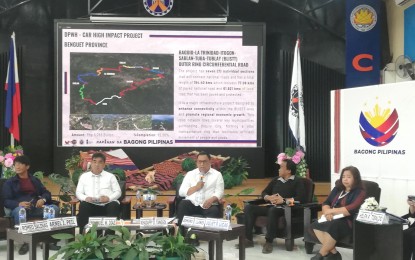
CONNECTIVITY. Department of Public Works and Highways Cordillera director Engineer Khadaffy Tanggol (3rd from left) during the Bagong Pilipinas press conference in Baguio City on Tuesday (May 28, 2024). He highlighted the importance of infrastructure development in the region to help spur economic growth. (PNA photo by Liza T. Agoot)
BAGUIO CITY – Construction and maintenance of an almost 300 kilometers road has linked the Cordillera Administrative Region (CAR) with Regions 1 and 2, resulting to easier transport of goods and services.
Department of Public Works and Highways-CAR (DPWH-CAR) director Engineer Khadaffy Tanggol told the Philippine News Agency on Tuesday that the road connectivity projects are aimed at providing alternative access roads that are especially helpful during calamities.
“When you bring roads to places which used to be unknown or unreachable, you are also opening business opportunities, thus making the economy and the lives of people better,” Tanggol said in Filipino.
In a briefing on Tuesday, Tanggol said the PHP14.28-billion Cordillera Inter-Regional Connectivity Project (CIRCP) involves the constructio of about 292 kilometers of road network that connects CAR to the Ilocos Region and Cagayan Valley, from 2018 until this year.
Specifically, he said the government spent PHP14.28 billion for the roads connecting Cordillera to Region 1 and PHP3.67 billion to connect CAR to Region 2.
An additional PHP11.7 billion is being proposed for more inter-region connectivity roads in from 2025 onwards, he said.
Tanggol said that inter-regional connectivity will further spur economic growth especially with the Cordillera being the top producer of semi-temperate vegetables that are transported within the region and to other regions in the country.
“If we go around travelling more hours to bring our highly perishable vegetables to the other regions, our farmers and the economy will suffer instead of providing more opportunities and income,” he said in Filipino.
Mountain Province and Benguet, where most vegetables come from, are directly accessible to Region 1 via the Bessang Pass and the municipality of Cervantes and Quirino aside from Isabela
Apayao and Kalinga provinces have also been connected to Region 2 through diversion roads that are shorter in terms of travel time.
Aside from inter-regional connectivity, the six provinces and two cities in CAR have long been connected.
As of December 2023, the 1,154 kilometers road that aims to establish a road backbone that will connect all provincial and major growth centers in the region is 99.45 percent, Tanggol said.
“Important road projects such as La Trinidad-Mount Data section, Baguio-Aritao, Apayao-Ilocos Norte have practically interlinked almost all provinces in the region and nearby regions significantly minimizing travel time,” DPWH said in a report released Tuesday
The DPWH report on high-impact projects also shows that in the Baguio, La Trinidad, Itogon, Sablan, Tuba and Tublay (BLISTT), the government has invested PHP9.78 billion for the 154.4 kilometers of outer ring circumferential road.
“This is a major infrastructure project designed to enhance connectivity within the BLISTT area and promote regional economic growth. This road network links several key municipalities surrounding Baguio City, forming a vital transportation ring that facilitates efficient movement of people and goods,” Tanggol said in the report.
Disaster preparedness
Tanggol said they have pre-positioned heavy equipment at the 12 district offices of the DPWH in the six provinces and two cities in the region for their immediate deployment in case of road closures due to landslides, flooding, road cuts and road closures.
“Our equipment are ready to be deployed in case they are needed. We are also augmented by the equipment from the local government units and the private contractors that are onsite,” he said.
The director said the department’s goal during calamities is to ensure that roads are kept open and accessible to allow goods and services to move faster, especially food supplies, relief items and rescue operatives.
Arnel Peil, president of the contractors association in the Cordillera said in Filipino, “There is an unwritten bayanihan spirit between us and the government, (and) even the community members during calamities.”
“We are simply told of the situation and we move because we also have a responsibility to our fellowmen, not just to our businesses and companies,” he added. (PNA)
